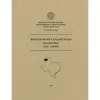Breadcrumb
Bureau of Economic Geology Publications
| Title | Publication Year Sort ascending | Abstract | Author | Publisher | |
|---|---|---|---|---|---|

|
Structural styles of the Wilcox and Frio growth-fault trends in Texas: constraints on geopressured reservoirs | 1986 | The wide variability in structural styles within the growth-faulted, geopressured trends of the Texas Gulf Coast is illustrated by detailed structural maps of selected areas of the Wilcox and Frio growth-fault trends and quantified by statistical analysis of fault compartment geometries. |
Ewing, T.E., Anderson, R.G., Babalola, O., Hubby, K., Padilla y Sanchez, R.J., Reed, R.S. | Bureau of Economic Geology |

|
Bouguer gravity Atlas of Texas, Tucumcari sheet | 1986 | This folded transparent map is at the same scale as its corresponding Geologic Atlas of Texas (GAT) sheet and can be superimposed on it to compare gravity information with surface geology. |
Keller, G.R., Aiken, C.L.V. | Bureau of Economic Geology |

|
Geochemistry of salt-spring and shallow subsurface brines in the Rolling Plains of Texas and southwestern Oklahoma | 1986 | Numerous salt-emission areas exist within the Permian outcrop in the Rolling Plains of Texas and southwestern Oklahoma. Sodium chloride waters underlie the area at relatively shallow depths, discharge from salt springs and salt seeps, and greatly impair the quality of ground and surface waters. |
Richter, B.C., Kreitler, C.W. | Bureau of Economic Geology |

|
Cyclicity in the Middle Permian San Andres Formation, Palo Duro Basin, Texas panhandle | 1986 | The San Andres Formation in the Palo Duro Basin is a middle Permian carbonate-evaporite sequence situated between two red-bed units, the underlying Glorieta and the overlying undifferentiated Queen-Grayburg sequences. |
Fracasso, M.A., Hovorka, S.D. | Bureau of Economic Geology |

|
Submerged lands of Texas, Brownsville - Harlingen area: sediments, geochemistry, benthic macroinvertebrates, and associated wetlands | 1986 | The State-owned submerged lands of Texas encompass almost 6,000 mi2 (15,540 km2). They lie below waters of the bay-estuary-lagoon system and the Gulf of Mexico and extend 10.3 mi (16.6 km) seaward from the Gulf shoreline (fig. 1). |
White, W.A., Calnan, T.R., Morton, R.A., Kimble, R.S., Littleton, T.G., McGowen, J.H., Nance, H.S., Schmedes, K.E. | Bureau of Economic Geology |

|
Chemical Characterization of Texas Lignite | 1986 | Statistical analysis of chemical data on Texas Eocene coals revealed startigraphic and geographic trends in lignite quality. Chemical data on near-surface coals wre obtained from various private and public sources. Seams from deep-basin coals were compared. |
Tewalt, S.J. | Bureau of Economic Geology |

|
Hydrogeology and hydrochemical facies of the San Andres Formation in eastern New Mexico and the Texas panhandle | 1986 | Fluid pressure, permeability, rates and patterns of ground-water flow, and chemical and isotopic composition of ground water in carbonate rock in the lower part of the San Andres Formation (Permian) in eastern New Mexico and the Texas Panhandle were studied to characterize the origin and movement |
Dutton, A.R., Orr, E.D. | Bureau of Economic Geology |

|
Compilation of potassium-argon ages of Tertiary igneous rocks, Trans-Pecos Texas | 1986 | This compilation of potassium-argon (K-Ar) ages of igneous rocks of the Tertiary volcanic field of Trans-Pecos Texas includes all published ages known to us as well as many unpublished results. |
Henry, C.D., McDowell, F.W., Price, J.G., Smyth, R.C. | Bureau of Economic Geology |

|
Hydrogeology of a gypsum playa, northern Salt Basin, Texas | 1986 | The northern Salt Basin in West Texas and New Mexico is a closed hydrologic system in which discharge of ground-water flow occurs in a series of playas, or salt flats. |
Boyd, F.M., Kreitler, C.W. | Bureau of Economic Geology |

|
Historical shoreline changes in Trinity, Galveston, West, and East Bays, Texas Gulf coast | 1986 | Changes in shoreline position occurring for more than a century provide estimates of the relative stability of shorelines and, along the Texas coast, allow comparisons of shoreline changes before and after human modifications became significant. |
Paine, J.G., Morton, R.A. | Bureau of Economic Geology |